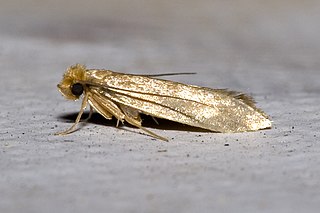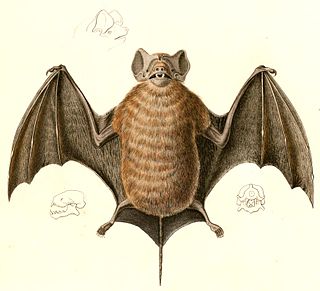Related Research Articles

Tineoidea is the ditrysian superfamily of around 4000 moths species including clothes moths, carpet moths, bagworms and relatives. There are five families usually included within it, Eriocottidae, Dryadaulidae, Meessiidae, Tineidae and Psychidae, whose systematics are still under‐studied.

The velvety free-tailed bat or Pallas's mastiff bat, is a bat species in the family Molossidae.

Enyo lugubris, the mournful sphinx, is a moth of the family Sphingidae. It is found from Argentina and Paraguay to Uruguay, Venezuela, Guyana, Surinam, French Guiana, Colombia, Ecuador, Peru, Brazil and the West Indies through Belize, Guatemala, Honduras, El Salvador, Nicaragua, Costa Rica and Panama to Mexico and the United States, where it has been recorded from Arizona east to Florida and north to South Carolina. Strays have been recorded from Arkansas, north to Illinois, Michigan and New York.

Caloptilia azaleella is a moth of the family Gracillariidae. It is endemic to Japan, but has been introduced worldwide, wherever there are Azaleas.

Achyra rantalis, the garden webworm, is a moth of the family Crambidae described by Achille Guenée in 1854. It is found in North America, where it has been recorded from Maine to southern Quebec and Ontario, south to Florida and Mexico. It has also been recorded from Iowa, Colorado, California and the West Indies. Its habitat consists of fields and gardens.

Phryxus is a monotypic moth genus in the family Sphingidae first described by Jacob Hübner in 1819. Its only species, Phryxus caicus, was described by Pieter Cramer in 1777. It is found in the Neotropics, although it has been recorded from southern Florida and South Carolina.

Schinia nubila, the camphorweed flower moth or brown flower moth, is a moth of the family Noctuidae. The species was first described by Herman Strecker in 1876. It is found from the US states of Oklahoma to New Jersey, south to Florida and Texas. Its range is expanding in the northeast. Furthermore, recorded from Colorado, Kansas, Oklahoma, Arkansas, North Carolina, South Carolina and Maryland.

Anthanassa frisia, the Cuban crescentspot, Cuban checkerspot or Cuban crescent, is a butterfly of the family Nymphalidae. Subspecies tulcis is known by the common names pale-banded crescent or Tulcis crescent; it is treated as a species by some authors. The nominate subspecies is found in the West Indies and southern Florida, with strays to northern Florida. Subspecies tulcis is found from Argentina north through Central America and Mexico to southern Texas, strays to west Texas and southern Arizona. Other subspecies are resident to South America.

Macaria abydata, commonly known as the dot-lined angle, is a moth of the family Geometridae. It is native from northern Argentina to the Caribbean and southern United States. It has been introduced to the Pacific and has spread rapidly since. The first introduction occurred in Hawaii in 1970. Further spread occurred as follows:

The geranium plume moth is a moth of the family Pterophoridae. It is found in western Africa, Madagascar, India, Sri Lanka, Thailand, Japan, the New Hebrides and Central and South America, as well as Australia, where it has been recorded from Cape York to central New South Wales. It is also present in the United States, where it has been recorded from Florida, as well as Mississippi.

Lorita scarificata, the chrysanthemum flower borer or Lora Aborn's moth, is a moth of the family Tortricidae. It is native to North America and is an introduced species in Hawaii.

Adaina bipunctatus is a moth of the family Pterophoridae. It is found in the United States, including Florida and Mississippi. It has also been recorded from Trinidad, the West Indies, Brazil and Ecuador.
Carectocultus perstrialis, the reed-boring crambid moth, is a moth in the family Crambidae. It was described by Jacob Hübner in 1831. It is found in North America, where it has been recorded from Florida, Georgia, Maryland, Massachusetts, Mississippi, Nova Scotia, Ohio, South Carolina and Texas. Outside of the United States, it has also been recorded from the West Indies and South America.
Cnaphalocrocis cochrusalis, the marasmia moth, is a moth in the family Crambidae. It is found in the West Indies, Costa Rica, Honduras and the United States, where it has been recorded from Florida, Louisiana, Mississippi, Oklahoma, South Carolina and Texas.
Diacme mopsalis, the mopsalis diacme moth, is a moth in the family Crambidae. It was described by Francis Walker in 1859. It is found in South America, Central America, the Antilles and the southern United States, where it has been recorded from Arizona, Florida, Oklahoma and Texas.

Diastictis argyralis, the white-spotted orange moth, is a moth in the family Crambidae. It was described by Jacob Hübner in 1818. It is found in North America, where it has been recorded from Colorado, Florida, Georgia, Indiana, Maine, Maryland, Mississippi, North Carolina, Ohio, Ontario, South Carolina, Tennessee, Texas and Virginia.

Macaria aequiferaria, the woody angle moth, is a moth of the family Geometridae. The species was first described by Francis Walker in 1861. It is found in North America, where it has been recorded from Maryland, and Delaware to Florida, west to Texas, as well as in Oklahoma, Mississippi, Kentucky and southern Illinois. It is also found in Mexico.
Mecyna submedialis, the orange-toned mecyna moth, is a moth in the family Crambidae. It was described by Augustus Radcliffe Grote in 1876. It is found in North America, where it has been recorded from Ontario and Michigan, south to Florida and west to Arkansas. It has also been recorded from Alberta.
Patania silicalis, the herbivorous pleuroptya moth, is a moth in the subfamily Spilomelinae of the family Crambidae. It was described by Achille Guenée in 1854. It is found in Brazil, Venezuela, Ecuador, French Guiana, Guyana, Guatemala, Costa Rica, Panama, Mexico, Cuba, Jamaica, Puerto Rico, Hispaniola and North America, where it has been recorded from Missouri, Michigan, Ohio and New York, south to Florida.
Penestola bufalis, the black penestola moth, is a moth in the family Crambidae. It was described by Achille Guenée in 1854. It is found in the US states of Texas and Florida, as well as on the Antilles. It is an accidentally introduced species on the Galápagos Islands. The habitat consists of coastal mangrove swamps and shorelines.
References
- ↑ "GlobIZ search". Global Information System on Pyraloidea. Retrieved 2014-07-15.
- ↑ mothphotographersgroup
- ↑ Bug Guide
| This Glyphodes-related article is a stub. You can help Wikipedia by expanding it. |